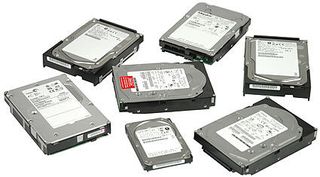Going the SAS Storage Way
SAS Raises Storage Capabilities To Higher Power

With the availability of Serial Attached SCSI (SAS) components, the next generation of business class storage technology has arrived. SAS, however, is not only the legitimate successor to UltraSCSI, but it will also enable new applications while boosting scalability to unprecedented levels. To demonstrate SAS' potential, we took a look at the technology, host adapters, hard drives and storage appliances.
SAS is not something entirely new, but it merges the best of two worlds. The first part is the serialized transmission of data, which requires far fewer physical connections. Moving from parallel to serialized operations has eliminated the use of a bus as well.Although the current SAS specification defines a 300 MB/s bandwidth per port, which is less than UltraSCSI's 320 MB/s, exchanging the sharedbus by point-to-point connections between devices is a huge advantage. The second important ingredient for SAS is the SCSI protocol, which is popular and powerful.
In addition to the interface specifics, SAS can take advantage of a large variety of RAID implementations. Storage giants such as Adaptec or LSI Logic offer comprehensive features that allow for expansion, transformation, migration, nesting and concurrency of RAID arrays across multiple controllers and drives.
Though almost being metamorphoses, most of these actions can even be performed on the fly today. In this context we should also mention the names AMCC/3Ware, Areca and Broadcom/Raidcore, because they helped move enterprise class features into the SATA space.
Compared to SATA, conventional SCSI is losing ground on all fronts, except for high-end enterprise applications. SATA offers adequate hard drives, attractive pricing and a wide selection of solutions. Another really smart feature of SAS is that it can be integrated with existing SATA infrastructures, which can be accommodated by SAS host adapters. However, SAS drives cannot run on SATA adapters.
Stay on the Cutting Edge
Join the experts who read Tom's Hardware for the inside track on enthusiast PC tech news — and have for over 25 years. We'll send breaking news and in-depth reviews of CPUs, GPUs, AI, maker hardware and more straight to your inbox.
Current page: SAS Raises Storage Capabilities To Higher Power
Next Page SCSI's Details And HistoryMost Popular

